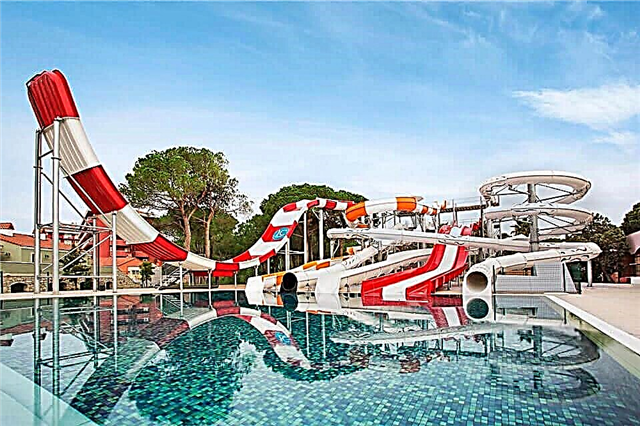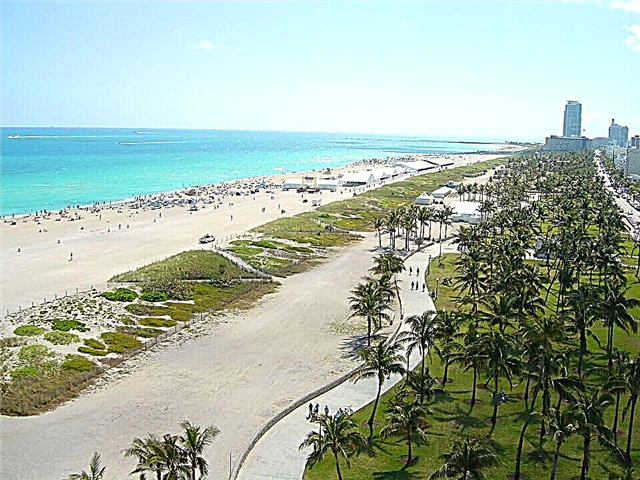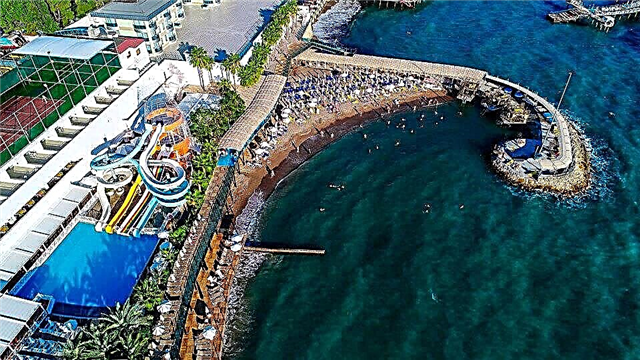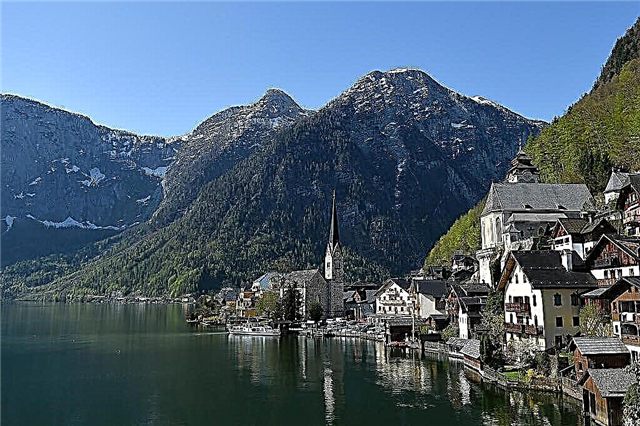Monasteries have long been the spiritual support of Russia. The first of them appeared about 1000 years ago. They played the role of fortresses that protected the state from invaders, pilgrimage and educational centers. Today there are over 900 Orthodox monasteries in our country. The most famous of them accept not only believers, but also tourists who are interested in Russian architecture and art.
Solovetsky Monastery
Article: Solovetsky Monastery - a powerful fortress on the Solovetsky Islands of Russia

View of the Solovetsky Monastery
The Solovetsky Monastery is an independent abode of the Russian Orthodox Church. It is located in the White Sea on the Solovetsky Islands. The founding of the monastery falls on the 40s of the 15th century, when the Monk Zosima and his companion chose Bolshoi Solovetsky Island as their place of residence. He made such a choice not by chance - the monk dreamed of a church of unprecedented beauty.
Recognizing his dream as a sign from above, Zosima set about building a wooden church with a side-altar and a refectory. By erecting it, he honored the Transfiguration of the Lord. After a short period of time, Zosima and Herman built a church. With the appearance of these two buildings, which later became the main ones, the arrangement of the monastery territory began. Subsequently, the archbishop of the Novgorod monastery issued a document confirming its eternal ownership of the Solovetsky Islands.
Svyato-Vvedenskaya Optina Hermitage
Article: Svyato-Vvedenskaya Optina Monastery - repository of the relics of the holy elders

View of the Holy Gates of the Holy Vvedenskaya Optina Hermitage
Svyato-Vvedenskaya Optina Hermitage is a stavropegic monastery, whose servants are male monks. Its creator was the robber Opta, or Optia, who at the end of the XIV century. repented of his deeds and accepted monasticism. As a clergyman, he was known as Macarius. In 1821 a skete was built at the monastery. The so-called hermits were settled in it - these are people who spent many years in complete seclusion. The monastery's mentor was the "elder". Over time, Optina Hermitage turned into one of the leading spiritual centers. Thanks to numerous donations, its territory has been replenished with new stone buildings, a mill and land. Today the monastery is considered a historical monument and has a different name - "Optina Pustyn Museum". In 1987 he entered the list of objects of the Russian Orthodox Church.
Novodevichy Convent
Article: Novodevichy Convent - the oldest Orthodox monastery for women

View of the Novodevichy Convent from the Novodevichy Ponds Park
The Novodevichy Convent, erected in the 16th century, at that time was located on Samsonov Meadow. Now this area is called the Maiden's Field. The cathedral church at the monastery was built in the likeness of the Assumption Cathedral - the "neighbor" of the Moscow Kremlin. The monastery walls and towers were built in the 16th - 17th centuries. On the whole, the architecture of the monastery conveys the Moscow Baroque style. The monastery owes its fame to the Godunov family. Boris Godunov lived here with his sister Irina before his election to the reign. Irina Godunova was tonsured with the name of Alexander and lived in separate chambers with a wooden tower. At the end of the XVI century. the territory of the monastery was replenished with stone walls and a dozen towers. In their appearance, they resembled the Kremlin buildings (there were square towers in the walls, and round towers in the corners). Their upper parts were trimmed with teeth. Today, the Novodevichy Convent combines both a museum and a monastery.
Kirillo-Belozersky Monastery
Article: Kirillo-Belozersky monastery: beauty and grandeur, history and facts

View of the Kirillo-Belozersky Monastery from the Russian North National Park
The Kirillo-Belozersky Monastery is located on the shore of Lake Siverskoye. It owes its appearance to the Monk Cyril, who founded it in 1397. Construction began with the arrangement of the cave-cell and the installation of a wooden cross over it. In the same year, the lighting of the first shrine took place - it was a wooden church, rebuilt in the name of the Dormition of the Most Holy Theotokos. By 1427 there were about 50 monks in the monastery. In the first half of the XVI century. a new life begins at the monastery - all Moscow nobles and tsars began to regularly gather in it on pilgrimages. Due to their rich donations, the monks quickly built up the monastery with stone buildings. The Assumption Cathedral is considered its main attraction. It appeared in 1497 and became the first stone building in the North. The monastery complex underwent various architectural changes until 1761.
Valaam monastery
Article: Spaso-Preobrazhensky Valaam Monastery - a special abode of the Russian land

General view of the Valaam monastery
Valaam Monastery is a stavropegic institution of the Russian Orthodox Church that occupied the islands of the Valaam archipelago (Karelia). The first mentions of him are found in the chronicles of the XIV century. Thus, the "Legend of the Valaam Monastery" informs about the date of its foundation - it is 1407. Already after a couple of centuries, 600 monks lived in the monastery, however, due to repeated invasions of Swedish troops, the island began to decline.
After another 100 years, the territory of the monastery began to be filled with cell buildings and auxiliary premises. But the main buildings of the monastery courtyard were the Assumption Church and the Transfiguration Cathedral. Wishing to create a New Jerusalem from their own monastery, the Valaam ascetics used the names of the New Testament period when arranging its sites. Over the years of its existence, the monastery has undergone many changes, and to this day it remains one of the most attractive historical monuments in Russia.
Alexander Nevsky Lavra
Article: Alexander Nevsky Lavra - an architectural complex built in memory of the Great Victory in the Battle of the Neva

General view of the buildings of the Alexander Nevsky Lavra
The Alexander Nevsky Lavra was founded in 1710 at the junction of the Monastyrka River with the Neva. The decision to build it was made by Peter I himself, who wished to perpetuate the victory over the Swedes in this area in 1240 and 1704. In the XIII century. Alexander Nevsky fought with hordes of Swedes, so he was subsequently canonized for good deeds before the Fatherland. The monastery built in his honor was popularly nicknamed the Alexander Church, and from its construction began the expansion of the territory of the Holy Trinity Alexander Nevsky Monastery, or Lavra. It is noteworthy that the monastery buildings were located in "peace", that is, in the shape of the letter "P" and were decorated with churches in the corners. The landscaping of the yard was a garden with a flower bed. September 12 is recognized as the main holiday of the Lavra - it was on this date in the distant 1724 that the holy relics of Alexander Nevsky were transferred.
Trinity-Sergius Lavra
Article: Trinity-Sergius Lavra - the largest center of Russian Orthodoxy, culture and spirituality

View of the Trinity-Sergius Lavra
The Trinity-Sergius Lavra was founded in the first half of the XIV century. the Monk Sergius of Radonezh, the son of an impoverished nobleman. According to the conception of the priest, the monastery courtyard was arranged in the form of a quadrangle, in the center of which a wooden Trinity Cathedral towered above the cells. A wooden tyn served as a fence of the monastery. Above the gates was a small church honoring St. Dmitry Solunsky. Later, this architectural plan was adopted by all other monasteries, which confirmed the opinion that Sergius was "the head and teacher of all monasteries in Russia." Over time, the Holy Spiritual Church appeared at the Trinity Cathedral, the building of which united a temple and a bell tower ("like under the bells"). Since 1744, the majestic monastery was renamed the Lavra.
Spaso-Preobrazhensky Monastery
Article: Seraphim-Diveevsky Monastery - the fourth earthly inheritance of the Mother of God

View of the cathedrals of the Transfiguration Monastery
The Savior Transfiguration Monastery is a monastic monastery in Murom, founded by the passion-bearer prince Gleb. Having received the city as an inheritance, he did not want to settle among the pagans, so he decided to arrange the prince's court upstream of the Oka. Choosing a suitable place, Gleb Muromsky built his first temple on it - this is how he immortalized the name of the All-Merciful Savior. Later, he supplemented it with a monastic abode (the premises were used to educate the Murom people). According to the chronicle, “the monastery of the Savior on the forest” appeared in 1096. Since then, many priests and miracle workers have visited its walls. Over time, the Savior Cathedral appeared on the territory of the monastery - through its construction, Ivan the Terrible immortalized the date of the capture of Kazan. For the arrangement of the premises of the new church, the tsar allocated icons, church utensils and literature, clothes for the ministers. The Church of the Intercession with chambers, a bakery, a flour plant and a cookery was built in the second half of the 17th century.
Seraphim-Diveevsky Monastery
Article: Seraphim-Diveevsky Monastery - the fourth earthly inheritance of the Mother of God

View of the Seraphim-Diveevsky Monastery
The Seraphim-Diveevsky Monastery is a women's monastery founded in the second half of the 18th century. At first, the foundation of the Kazan Church was laid with Mother Alexandra's own funds. Pakhomiy, a master known for the construction of the Sarov desert, was engaged in its consecration as the construction was completed. The premises of the church were equipped with 2 chapels - in the name of Archdeacon Stephen and Saint Nicholas. Then the Trinity and Transfiguration Cathedrals appeared in Diveyevo. The latter was built on solid donations, because reinforced concrete was used for the first time in its construction (previously such material was not used in the construction of shrines). But the main temple here is considered to be the Trinity Cathedral, in which the relics of Seraphim of Sarov rest. All who wish to receive blessed help and healing specially gather at the shrine with the relics of the monk.
Pskov-Pechersky Monastery
Article: Holy Dormition Pskov-Pechersky Monastery - the northwestern border of Orthodoxy

View of the buildings of the Pskov-Pechersky Monastery
The Pskov-Pechersky Monastery was founded in 1473, when the Dormition Church was consecrated, dug in a sandy hill by the Monk Iona (it was located near the Kamenets stream). During the first 500 years of its existence, the monastery experienced many different bad events, and it was only under the abbot Dorofey that it experienced a period of prosperity. Already in the 20s of the XVI century. the Church of the Assumption was improved and expanded, other temples and buildings for various purposes appeared. The sovereign clerk Misyur Munekhin was in charge of the construction work. For the construction of the monastery, he did not spare any funds, therefore, after his death, he was buried in a cave at the monastery (earlier the laity did not rest here). The next period of prosperity of the monastery fell on the years of service in it of Abbot Cornelius. Under him, the monastery became known as never before. Thanks to the funds of the pilgrims who flocked to the courtyard in streams, the once wretched monastery was replenished with lands, estates and precious contributions.











